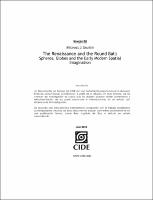| dc.creator | Sauter, Michael J. |
| dc.date.issued | 2013 |
| dc.identifier | 121058.pdf |
| dc.identifier.uri | http://hdl.handle.net/11651/972 |
| dc.description.abstract | The contemporary literature on the Renaissance invention of terrestrial globes is fixated on the images that globemakers drew, expending great energy in determining how “correct” they were. This essay, in contrast, understands the history of globes through the rise of a new ways of projecting space and argues that the application of a homogenous and homocentric spatial aesthetic to the cosmos made the Renaissance’s global thought possible. This spatial aesthetic emerged in the course of the fifteenth century, with the return of Claudius Ptolemy’s Geography, and yielded the long-standing practice of globe pairing. From roughly 1450 until 1850 terrestrial globes were regularly paired with celestial ones, as the celestial and the terrestrial were place under one spatially defined rubric. The history of globes is, thus, not about the images that were painted on round balls, but the space in which geographic thought became possible. |
| dc.description.abstract | La bibliografía contemporánea sobre la invención renacentista de globos terráqueos está obsecionada en las imágenes dibujadas por los constructores de globos terráqueos, invirtiendo gran cantidad de energía en determinar que tan “correctos” eran. En contraste, este ensayo entiende la historia de los globos a través del surgimiento de nuevas formas de proyectar el espacio y argumenta que la aplicación de una estética espacial homogénea y homocéntrica al cosmos hizo posible el pensamiento global renacentista. Esta estética espacial surgió en el transcurso del siglo XV, con el retorno de la Geografía de Claudio Ptolomeo, dando paso a la larga práctica del emparejamiento de globos. Desde, aproximadamente, 1450 hasta 1850 los globos terráqueos se emparejaban con los celestes, y ambos se colocaban en una categoría espacial definida. Por consiguiente, la historia de los globos no trata sobre las imágenes pintadas en bolas redondas, sino sobre el espacio en el que el pensamiento geográfico se hizo posible. |
| dc.format | application/PDF |
| dc.language.iso | eng |
| dc.publisher | Centro de Investigación y Docencia Económicas, División de Historia |
| dc.relation.ispartofseries | Documento de trabajo (Centro de Investigación y Docencia Económicas). División de Historia; 80 |
| dc.rights | El Centro de Investigación y Docencia Económicas A.C. CIDE autoriza a poner en acceso abierto de conformidad con las licencias CREATIVE COMMONS, aprobadas por el Consejo Académico Administrativo del CIDE, las cuales establecen los parámetros de difusión de las obras con fines no comerciales. Lo anterior sin perjuicio de los derechos morales que corresponden a los autores. |
| dc.subject.lcsh | Terrestrial globes -- History. |
| dc.subject.lcsh | Renaissance. |
| dc.title | The renaissance and the round ball: spheres, globes and the early modern spatial imagination |
| dc.type | Documento de trabajo |
| dc.accessrights | Acceso abierto |
| dc.recordIdentifier | 000121058 |
| dc.rights.license | Creative Commons Reconocimiento-NoComercial-SinObraDerivada 4.0 International CC BY-NC-ND |


